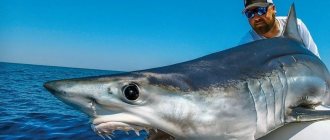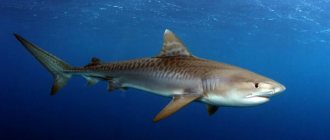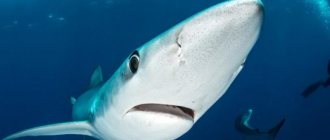The bull shark is a completely unique creature. It is this fish that is responsible for more than half of the cases of shark attacks on swimmers. This fish is the only shark that can live in fresh water for a long time.
And it is this shark, with its disgusting reputation, that can be found in the waters of all oceans. Let's take a closer look at these phenomenal predators.
The bull shark, also known as the blunt-nosed shark, belongs to the Carcharhiniformes family. This creature received its strange name for a fish for its ferocious, unpredictable temperament, and for its ability to live and hunt in fresh waters: when shepherds drove the herd to watering, bull sharks dragged large bulls into the dark waters.
Blunt shark - a danger to humans
We can say with great confidence that sharks should be avoided in general, regardless of type and size. As for the blunt-nosed sharks, they should be feared most of all. In particular, due to the fact that they are very unpredictable and extremely aggressive against humans or any other creature. However, there are practically no cases of this predator attacking a group of people or marine animals. Therefore, if you go swimming, do not do it alone. Another important point is that the blunt-nosed shark feeds at dawn and dusk. It is not recommended to swim too far or enter the water at all if there may be a predator in it, as there is a risk of becoming its prey. And in general, it’s definitely not worth swimming on the beach or in the river, where this cannibal could presumably end up. Moreover, this representative can be found in both salt and fresh water, the main thing is that it is warm. It always makes sense to swim as close to the shore as possible. Often, the gray bull shark, or tiptoe shark, does not swim too close to shallow water.
Social structure and reproduction
Photo: Snout shark
They live alone; if individuals of the same sex meet, this most often leads to a fight, or they simply disperse. But individuals of different sexes can sometimes form a pair, although most often for a short time, and even hunt together - this happens when there is a good food supply.
Hunting together allows them to deceive the prey, which is initially attacked by only one shark, and when the victim's attention is absorbed, a second one suddenly attacks. If the union gives results and hunting becomes easier, they can repeat a similar move several times, but such a “union” still does not last long, since by nature these fish are solitary.
They reach sexual maturity by 10 years. The mating period begins in August-September, preceded by a mating ritual in which the predatory habits of blunt-nosed sharks are fully manifested: during this ritual, the males bite the females by the tail, trying to get them to turn belly up - this is how they make it clear that they are ready to mate.
The bites are very strong, and they can leave wounds for a long time - although the females still do not feel pain due to substances produced in the body that block pain. Males produce a lot of testosterone at this time, which is why they become very aggressive.
Its level in blunt-nosed sharks is generally elevated, which explains their behavior. Sometimes they experience hormonal disruptions at other times, then they literally start throwing themselves at everything, even inanimate objects, and can get hurt on a rock or attack a shark much larger than themselves and die.
Females do not have maternal instinct, and when childbirth ends, they simply swim away. Small sharks - usually from 4 to 10 of them appear - have to immediately take care of themselves. At first they live in fresh water, and only as they mature they acquire the ability to live in salt water - although they do not always move into it.
In rivers, young sharks are threatened by fewer predators, and they often go to sea after growing up because there is more prey there. This usually happens by 3-5 years, when they reach a size of about 2 meters and they do not have many worthy opponents in coastal waters.
Where does he live?
It is noteworthy that quite often the bull shark enters rivers. Which is unusual for other species. It goes very far upstream, but in most cases does not descend to a depth of more than 30 meters. If we talk about the Atlantic Ocean, then it can be found near the coasts of Southern Brazil, the USA, Morocco and Angola. The original home of this predator is considered to be here. The blunt-nosed shark is found almost everywhere. It can be seen from the coastal zone of Africa and all the way to Kenya. The bull shark visited and here it can be found around almost all the islands. These sharks are only found along the southern side of Australia. The dangerous predator thrives in the murky waters of the Amazon and is very often found on the Ganges River. The bull shark loves warm currents and tries to avoid temperate latitudes.
bull is the only shark that lives in fresh water
The blunt-nosed shark, or bull shark, is an absolutely unique creature that can cause horror if only because more than half of the human victims are attributed to representatives of this species. It was the bull shark or, as it is otherwise called, the mug-head, one of the most aggressive predators living in the ocean, that served as the prototype for the monster from the movie “Jaws.”
In addition, this is the only one of the 43 species of sharks that can thrive in both salt and fresh water (for example, one of the representatives of this species was seen 4000 km upstream of the Amazon in South America).
What is the secret of the bull shark's ability to live in fresh water?
Most sharks have a salt concentration in their blood similar to that found in seawater. And in blunt-nosed predators, by the way, it is only 50%, which in a fresh environment causes a large outflow of water through the gills and leaching of chlorine and sodium from the fish’s body.
This shark is saved by the rectal gland, liver, kidneys and gills, which are capable of accumulating and then releasing the necessary sodium and chlorine, which maintains its water-salt balance and, accordingly, facilitates adaptation in fresh water.
Researchers, by the way, drew attention to the fact that young individuals are still most often found in fresh water, and adults swim here mainly to give birth to offspring, since this tactic helps the young survive.
What does a bull shark look like?
The blunt-nosed shark makes an indelible impression on those who meet it. It has a large body, while females are noticeably larger than males and can reach 4 m in length, while their gentlemen grow mainly up to 2.5 m. The weight of this shark can also be called bullish - 300 kg!
The spindle-shaped body of the predator, like that of all its relatives, ends in a massive head, with a blunt, wide muzzle and, of course, terrifying jaws.
The teeth of our “beauty” are perfectly adapted for gnawing any kind of surface, even a turtle shell. They are very sharp, triangular in shape with highly jagged edges and curved inward. By the way, as soon as any of the teeth falls out, a new killing device grows in its place.
The shark is painted gray-blue, and its belly is light, almost white.
Where does the blunt-nosed shark live?
The main habitats of the bull shark are the coastal warm and moderately deep waters of the southern hemisphere (from approximately 30 to 150 m depth). Its home is the Atlantic, Pacific and Indian oceans.
But it would be more correct to call these hunters migrants, since in search of food they are able to swim into rivers and even into some lakes, where they sometimes live for several years. The rivers favored by sharks include the Amazon, Potomac, Mississippi, Brisbane, Ganges and Brahmaputra. More than once, the bull shark was also encountered in Lake Nicaragua (Central America), where it was long considered an endemic species, and in some other freshwater bodies of sufficient depth (at least 30 m).
By the way, this representative of the class of cartilaginous fish is the most common species of sharks known throughout the world.
Features of the life of a bull shark
The bull shark has become famous for its unpredictably aggressive behavior (for which, by the way, it got its name) and is considered one of the most dangerous predatory fish for humans. By the way, it is the male specimens of blunt-nosed sharks that are famous for their aggressiveness. This is apparently due to the fact that they live in areas where large numbers of swimmers or water sports enthusiasts can be found.
Despite the prevalence of these fish, there are still unclear aspects in their behavior and life characteristics. And it is well known that this is the most socialized species among its kind. Sometimes bull sharks hunt in pairs or small groups, in which the females clearly dominate the males, although most often they, like most of their relatives, prefer solitude.
In search of food, without trying to find a fishing spot, the bull shark absorbs everything that comes in its way. It can attack dolphins and even tiger sharks or the infamous great white sharks. She is attracted to crabs, crayfish, shellfish, all types of fish and sea carrion.
Reproduction of the blunt-nosed shark
The described shark reaches sexual maturity at 10-15 years (with an average life expectancy of up to 28 years). Her breeding season spans the last month of summer and the beginning of autumn. This species of shark is viviparous, as females carry fertilized eggs in their bodies for 10-11 months until they mature.
In its environment, the bull shark is the dominant predator and therefore has no enemies, which cannot be said about its offspring, and this is reflected in the reproductive characteristics of this fish. Thus, for childbirth in brackish river estuaries, huge flocks of pregnant females usually gather, and each gives birth to from three to thirteen fry, the body length of which, as a rule, does not exceed 60 cm. The mothers immediately leave the cubs to their fate and more about them don't care. But, as mentioned earlier, in freshwater bodies, sharks forced to fight for life on their own have a better chance of surviving.
Blunt sharks are dangerous to humans
The bull shark often attacks both animals that come to drink and people who have lost their vigilance. She attacks with lightning speed, immediately knocking the victim down.
These fish are especially dangerous in the morning and evening, when it is time for them to hunt. Therefore, the population living along the rivers where the bull shark is found strictly follows the safety rules:
- You cannot go into the water alone;
- It is dangerous to swim in muddy water (which is where sharks like to hunt), especially after rain, which washes away organic matter from nearby fields;
- long-distance swims can also end tragically.
fb.ru
Third place - tiger shark
Tiger shark
You can recognize the ferocious predator by the presence of dark gray transverse stripes decorating its 4.5-meter body. The tiger shark's habitat is the coastal zone of Central America, the islands of Oceania, Australia, Africa, New Zealand and Southeast Asia. Sea nomads are also found in the warm waters of the Persian Gulf and the Red Sea. They go fishing mainly at night, and during the day they prefer to bask in the sun, swimming close to the beaches.
This huge fish does not specialize in specific prey. Her menu is amazingly diverse and includes any organic food. The toothy thunderstorm of the oceans easily splits the shell of a turtle, catches sea snakes, birds, dolphins and seals. She does not disdain carrion and edible waste from ship galleys. Objects that had nothing to do with food were found in the stomachs of caught tiger sharks: shoes, elements of anchor chains, bottles and car tires. A hungry hunter indiscriminately rushes at moving and stationary objects. A swift attack leaves the victim no chance. Every year, 3–5 tiger shark attacks on people are recorded worldwide.
Whale
animalreader.ru
The whale shark (lat. Rhíncodon týpus) is the largest species of shark currently existing, as well as the largest modern fish. The maximum length is 12.65 meters, sometimes up to 18-20 m.
It feeds mainly on plankton and stays near the surface of the water. The whale shark poses no danger to humans. She usually does not react to divers who may touch her body or even ride on her back.
Whale shark habitats
It is most often found near Taiwan, off the Seychelles, the coasts of East and Southeast Africa, off the coast of Mozambique, in the Gulf of Mexico, the waters of the Philippines, off the coast of Chile and Australia.
Behavioral characteristics of the gray bull shark
Blunt sharks hunt mostly alone, sometimes in groups sticking to the bottom of the reservoir, only occasionally rising up the riverbed far, far from the mouth. They have adapted to life in muddy water and poor lighting.
Known for their aggressive attitude, males protect the territory from strangers, including people, and it is not difficult for them to attack an unprotected person. These predators tend to live in shallow depths, surveying their environment. But this should not be neglected. The gray bull shark can attack with lightning speed, ferocity and mercilessness.
Best articles: Order Rodents: classification, characteristics, nutrition, behavior, reproduction and significanceIt is found in the forest, and the shark is in the sea, we all know from early childhood. But just as wolves can live in sandy or snowy deserts, sharks sometimes feel quite good in fresh waters.
Of the 550 species of these cartilaginous fish, approximately 15-20 swim into estuaries, river mouths, and sometimes rise quite high upstream.
One of the most famous serial shark attacks on humans took place in the river. But this is still not the typical behavior of sea predators, which spend most of their time in salty waters. At the same time, there are some species that love coastal places more than others and more often swim into shallow bays and the mouths of large rivers.
For example, similar habits are characteristic of the fairly well-known dog, which is also called bullish. This relatively slow and omnivorous predator is not averse to “feasting” on garbage or carrion, but at the same time quite often attacks humans, sometimes with fatal consequences.
Watch video - Snout shark:
Some other closely related species belonging to the large group of gray sharks also have similar habits. But, nevertheless, they are all sea inhabitants. Even the so-called “Ganges shark” is just part of the population of fish that constantly live in the seas and only periodically enter the river.
So do freshwater sharks exist? The kind that spend their entire lives in rivers or lakes and reproduce there?
Origin of the species and description
Photo: Snout shark
The oldest sharks lived on the planet in very ancient times - in the Upper Devonian. These were Hybodus, and they resembled sharks, although it is not clear whether they are evolutionarily related. In those days, the number of genera and species of Paleozoic sharks grew rapidly, but it all ended with the extinction of the vast majority in the Permian period.
Already in the Mesozoic era, the first modern sharks appeared: Elasmobrachians then divided into sharks and rays. The vertebrae in the skeletons of sharks calcified, which made them stronger and helped them survive high pressures (this allowed some species of sharks to move to depths), making them more maneuverable and dangerous predators.
Video: Snout shark
The brain grew, mainly due to sensory areas - then sharks acquired their famous sense of smell, which allows them to sense a drop of blood from kilometers away. The jaw bones have changed, allowing the mouth to open much wider. In short, they became very similar to the sharks we know back in the days of dinosaurs.
At the same time, the bulk of modern orders appeared, in particular, the carchariformes, which include the blunt-nosed shark. It is part of the family and genus of gray sharks: in total there are 32 species, and one of them is the blunt-nosed shark. Its scientific description was made by Müller and Henle in 1839, the species name in Latin is Carcharhinus leucas.
Interesting fact: Due to the lack of a swim bladder, sharks have to move all the time, and this requires a lot of energy. It is the need to constantly replenish it that causes their appetite, but they also know how to save money - to do this, they turn off unclaimed areas of the brain.
Freshwater sharks exist
It turns out yes. Moreover, they are represented by one single species known to science. There is only one place on Earth where purely freshwater sharks constantly live, and not some small thing, but very large predators, sometimes.
This lake is located in Central America and is called Nicaragua (the same as the country in which it is located).
The lake is quite large (the largest in Mesoamerica). From its shores it is very close to the Pacific Ocean, with which, however, there is no direct water communication. But the San Juan River connects the reservoir with the Caribbean Sea.
There is a version that it is along this river that sea predators swim from the Atlantic.
Watch video - Freshwater sharks in rivers:
But today most researchers have a different opinion. They believe that freshwater sharks have been isolated for a very long time - since millions of years ago, this former sea bay separated from the World Ocean.
But many local fishermen are sure that there are two types of sharks in the waters of Nicaragua. Allegedly, some live here permanently, while others come from below along the river.
Top articles: What are the differences between the ocean and the sea?
But ichthyologists do not confirm these stories, identifying the Nicaraguan inhabitants as a special species, Carcharhinus nicaraguensis, which, however, is sometimes called the freshwater form of the bull shark.
And along the rapids of the San Juan it would be quite difficult to climb even the 200 kilometers separating the lake from the ocean. So, most likely, the scientists are right - the predators, who were once sea inhabitants, were indeed able to fully adapt to the local conditions.
It is interesting that in Nicaragua, in addition to sharks, there are also freshwater sawfish, stickfish and one species of large typical ocean herring.
And very close by is another smaller lake, called Managua, connected to the first by a small river. So, all these sea “guests” are not observed in it!
Is the Indian river shark a man-eater? ∞ Shark Lagoon
Even 20-30 years ago, it was believed that the Indian shark (lat. Carcharhinus gangeticus) lives in the coastal continental zone of the seas and at the same time enters large rivers, for example, the Ganges (from which it received its Latin name).
This species was considered as the closest relative of the widespread blunt-nosed or bull shark (lat. Carcharhinus leucas).
The latter is also capable of spending a lot of time in fresh waters and even has relatives who constantly live in Lake Nicaragua.
Species of Indian shark
However, in recent years it has become clear that the species inhabiting the Ganges and other rivers of India should be placed in the genus Glyphis. So today this species has received the scientific name Glyphis gangeticus - Indian river shark, or Gangetic shark.
To finish with questions of terminology, let us mention two more species with similar names.
First of all, it is a close relative of the bull shark, the Indian night shark (also known as the hardnose shark, lat. Carcharhinus macloti). This predator is quite widespread along the entire coast of South and Southeast Asia.
Also sometimes the Indian gray shark is called a representative of a completely different family of carchariformes, Hemipristis elongates.
Watch video - Indian river shark:
The freshwater Gangetic shark has so far been studied very poorly. This is a rare and scarce fish. Its usual dimensions are up to 2 meters in length.
The body shape is quite typical for all carcharines. Five gill slits, a high first dorsal fin and a lower second. Anal - even less.
An important feature is the clearly visible free petals extending posteriorly from both dorsal, pelvic and anal fins.
The pectoral fins are quite large, having a slightly rounded crescent shape. Powerful and asymmetrical tail with an upper lobe protruding backwards. The color of the Indian shark is gray or brownish. The snout is wide, rounded, the eyes are small.
The Ganges shark is common in many rivers of North-East India - Brahmaputra, Orissa, Mahanadi, Assam. In Bengal it is called tiger fish. Inhabits estuaries, estuaries and coastal sea waters.
Apparently, it feeds mainly on fish and crustaceans. Viviparous, the cubs at birth measure 55-60 cm.
The Indian shark is a commercial target. In addition to meat and large pectoral fins, the fat from its liver is also valued.
How dangerous is the Ganges shark to humans?
In general, it is worth considering that the rivers and coastal waters in which this species of selachians live are inhabited by numerous peoples who are not at the highest level of development. Therefore, the hunting of the Ganges shark is carried out quite actively and leads to a significant decrease in the population.
Today, serious measures are being taken to protect it, but the situation remains very difficult for the conservation of the species.
The Indian shark does not have the most reliable reputation. You can often read that this predator is extremely dangerous to humans. However, it is quite possible that there is typical confusion here when one species of shark is credited with the “merits” of another.
As we already wrote above, the Ganges shark can easily be confused with the blunt-nosed (bull) shark, which is very common throughout the world. This predator, known for its bloodthirstiness, also swims into rivers, sometimes rising quite high along them.
It is the bull shark that holds one of the first places in the number of unprovoked attacks on humans, including fatal ones.
The slow-moving, indiscriminate predator is also a corpse eater, devouring various carrion and waste (it is likely, however, that the latter is also characteristic of the Ganges shark).
Watch video: Bull shark - the most dangerous shark in the world
Here it is worth noting some features of the region. The Ganges River is considered sacred by the local population. Every year tens of millions of people come here for pilgrimage. In addition to the ablutions and holidays, a common ritual is also the burial of the ashes of the dead in the river.
Usually the dead are cremated first, but the poor often simply put the body in water.
Of course, such “bait” could not but affect the culinary tastes of the local river inhabitants. It is known for certain that carrion is included in the diet of the blunt-nosed shark. There is no exact data about its relative, the Indian river fish.
Another feature of Bengal is frequent floods in the lower reaches of large rivers. Sometimes hundreds of people die as a result of disasters.
So, although the Indian shark is often considered unfairly offended, the likelihood is quite high that everything is not so simple here. After all, nature itself made sure that human meat was included in its diet, albeit not constantly, but at least periodically.
It’s not for nothing that Bengalis call it “tiger fish.” The striped predator also usually does not attack humans. However, there are known cases where man-eating tigers accounted for hundreds of human victims.
laguna-akul.ru
Second place - white shark
Great white shark
The “Queen of the Seas” is called the legendary predator, whose body length varies from 4.6 to 5 meters. The owner of five rows of teeth and keen eyes, capable of seeing in pitch darkness, hunts off the coast of waters of subtropical and tropical latitudes. The attack tactics are thought out to the smallest detail: the white shark tracks down its prey and inflicts numerous bites, repeating the attack over and over again. According to unofficial sources, between 20 and 30 attacks on people are recorded annually.
In addition to well-developed hearing, vision and smell, representatives of the large shark family have another natural gift - electroreception - the ability to perceive changes in magnetic and electric fields. It is impossible to hide from underwater hunters. Fierce creatures unerringly find even a victim buried in the sand, reacting to the beating of its heart and the movement of its gills. White sharks are most sensitive to vibrations. For this reason, you will not find the mistress of the seas in any aquarium in the world. Constant vibrations, noise and radiation from devices disrupt the delicate sensory perception of fish.
Blue
nashzeleniymir.ru
The blue shark, or blue shark, or great blue shark, or mokoi (lat. Prionace glauca) is a species of cartilaginous fish from the family of gray sharks of the order Carchariformes, allocated to the monotypic genus Prionace
.
As of 2011, 34 attacks were recorded, of which 8 unprovoked attacks were fatal. In the fall of 2022, an attack by a school of blue sharks on illegal migrants in distress off the coast of Libya in the Mediterranean Sea was recorded. At least 31 people died in the emergency.
Habitat
The habitat of this shark species is temperate and tropical waters. The blue shark lives at depths from 0 to 350 meters. Blue sharks are found off the coast of all continents except Antarctica. The largest concentration of sharks of this species is in the Pacific Ocean.
The most dangerous shark species
Bull shark
The most dangerous type of shark is the bull shark. The body of males produces a huge amount of testosterone - the hormone of aggression, which is the cause of unreasonable rage. The bull shark owes its name to its physique. The white-bellied gray body, 2.5–4 m long and weighing up to 200 kg, ends in a large head with a short square muzzle. The huntress looks at the world with small, angry eyes, her impressive jaws are decorated with triangular teeth arranged in several rows. Aggressive creatures live in tropical and subtropical waters of the World Ocean. In search of prey, they can swim in temperate waters.
Over the past 155 years, 104 bull shark attacks on people have been recorded. The greatest danger to humans is that marine aggressors have the ability to adapt to fresh water. There are documented facts of the appearance of predators in the Mississippi, Amazon, Ganges, Zambezi rivers, lakes Nicaragua and Michigan. Since these sharks prefer to settle in murky waters, their attacks go unnoticed until the last seconds.
A date with the most dangerous species of sharks - longtip, mako, tiger, white and bull - can turn into an irreparable tragedy. Fortunately, ichthyologists say that the meeting between a man and a shark is more of a phenomenon than a pattern. But to avoid even the slightest chance of encountering a huge fish, lovers of swimming, sunbathing and surfing should avoid traveling to resorts where sea monsters are found. Among the unsafe beaches are the shores of Hawaii, California, Florida, Australia and South Africa.
Sharks live in the Kolyma River ∞ Shark Lagoon
Mid-August in the Magadan Territory - the height of the salmon run - was marked by an unusual catch in the Oirinskaya Spit area in 2013. Judge for yourself, a shark in Kolyma is an almost sensational fact.
True, these predators are not uncommon in the Sea of Okhotsk, but they are not an everyday occurrence either. But on the Kolyma River - this is exclusive news.
The predator was caught along with other fish; it became entangled in a fishing net.
The specimen was of decent size and weighed about 300 kg; according to one of the fishermen, one liver of the predator weighed 30 kg.
To date, the largest salmon shark encountered by humans is almost 4 meters in length and weighs about 450 kg.
The toothy predator had a photo shoot and published “press releases” in local newspapers, in which scientists expressed their opinion about this unusual event.
The shark caught in Kolyma turned out to be a representative of the herring family and belonged to the species of salmon sharks. Interestingly, this species of predator - Lamnidae ditropis - was first described in the scientific literature only in 1947 by US ichthyologists Follett and Hubbs.
How dangerous is the herring shark to humans?
What is even more interesting is that previously caught sharks of this species were ranked among the most dangerous predators among sharks - great white sharks, which immediately terrify divers and swimmers at their mention.
The salmon shark in Kolyma, unlike the great white, has different taste preferences, so it is potentially dangerous only in theory - due to its large size and deadly jaws.
This “sturgeon lover” has not yet left any episodes of aggressive clashes, much less bloody attacks on humans, in history.
Moreover, the salmon shark itself has become a target of fishing for its tasty meat - it is considered a delicacy in East Asia and Japan.
In the waters of Russia and many other countries, there is no special fishing for this shark; it is caught by fishermen as an accidental catch.
According to unofficial statistics, the annual bycatch of the salmon predator amounts to up to 6 thousand individuals.
Watch the video - In Magadan, fishermen caught two large sharks in a net:
How did the shark appear in Russian waters?
So we can say with complete confidence that the shark in Kolyma was not a random guest. The only unusual thing about her visit was the shallow detection depth in coastal waters.
However, according to the head of the MagadanNiro laboratory, this is not a sensation, since even dolphins can be found off the coast of Magadan during such hot periods.
In addition, the salmon shark is warm-blooded; this predator has endothermic regulation, that is, its body temperature can differ from the temperature of the surrounding aquatic environment.
In the entire shark superorder, only predators from the herring family have this unique natural quality (the great white shark also belongs to them), therefore, it is obvious that only such a shark in Kolyma could show its fin.
Its natural habitat is boreal waters, i.e. that part of the World Ocean between the Arctic and the Tropics where there are seasonal temperature fluctuations.
It is interesting that it is the boreal waters that are distinguished by their quantitatively diverse biomass, and the meeting place of warm and cold waters has always been the most favorable for the emergence and development of phytoplankton and, as a consequence, the appearance of a large number of fish.
Local fishermen successfully catch here, in addition to salmon and sturgeon, nelma, vendace, peled, omul, whitefish and further down.
The only natural barrier to the widespread distribution of salmon sharks in Kolyma rivers and lakes is depth, ice cover and summer “shallowing”, when the water level in the rivers decreases.
Therefore, the salmon shark in Kolyma is still more of a guest and not a native inhabitant.
What other sharks are found in Russian waters?
But in the Sea of Okhotsk, it is destined for a comfortable existence along with two more representatives of its shark family - the katran (or spiny shark) and even the polar one.
The latter can sometimes be found in this water area during its migration season, and the katran can be in the Sea of Okhotsk almost all year round.
Katran is the most famous shark in our country; its populations are present in both the Baltic and the Black Sea.
However, these shark “natives” are not dangerous to humans, however, the water temperature in the Sea of Okhotsk is not very conducive to swimming (up to 15 degrees in summer).
Watch video - Katran Sharks:
In the Kolyma River in the middle of summer, the water can warm up to 20 degrees and, probably, this state of water in the future will have a significant duration due to general global warming.
So the possibility of more frequent visits of herring shark species to the Kolyma “backwaters” rich in sturgeon and salmon cannot be ruled out.
The most recent recorded case of a meeting of a large shark from the herring family with a person occurred in the Magadan region in September 2015 - fishermen caught a 2.5-meter herring shark in a net.
laguna-akul.ru
Appearance of a predator
The body of the bull shark is stocky, this is the simple reason why people call it “bull shark”. This also corresponds to the aggressiveness of this representative of gray sharks. Males are slightly smaller than females. The length in most cases is no more than 2.5 meters, and the weight is about 130 kg. At one time there was talk that fishermen managed to catch a female 4 meters long, but there is no evidence of this. It is noteworthy that the blunt-nosed shark, according to researchers, can weigh more than 315 kilograms. The number of dorsal fins is 2. Moreover, the first is slightly larger and higher than the second. The caudal fin is notable for the fact that it is an order of magnitude longer than that of other representatives of the gray shark family, and it is also located slightly lower. The predator's jaws are clenched very tightly. The bull shark also becomes very dangerous because it is quite difficult to spot. This is due to the gray back, which is completely invisible, especially in muddy water. belly
Best articles: Leopard, or leopard, or panther
Gray reef
pyatzvezd.ru
The reef shark (lat. Triaenodon obesus) is the only species of the genus of reef sharks from the family of gray sharks of the order Carchariformes. Most often, it lives near rocks and coral reefs located in the Red Sea, as well as the Pacific and Indian Oceans. They are found at depths from 1 to 330 meters. The tips of the fins of this species of shark are painted white. The reef shark hunts at night.
They pose some danger to humans, and cases of attacks, mostly provoked by humans, have been recorded. She is capable of becoming furious even from minor vibrations of water and without hesitation attacking the source of irritation.
Habitat areas
Reef sharks are widely distributed in the Indo-Pacific region from the Red Sea and the east coast of Africa to Indonesia and the Arafura Sea, off the coasts of Panama and Costa Rica. They rarely swim near the bottom. The reef shark is the most common species at depths of 8-40 meters. Sometimes they can still swim into shallow water no more than one meter deep.
Fifth place - longtip shark
Longtip shark
The habitat of the 3.5-meter shark, which received its name for its long pectoral fins reminiscent of bird wings, is the Pacific, Indian and Atlantic oceans. This predator prefers to navigate the waters alone. Its menu includes large fish, shellfish and squid. Possessing an excellent sense of smell, the sea monster not only senses the smell of prey, but also determines the location of its source. During a hunt, a shark does not know any sense of proportion - it hunts without even feeling hungry.
Until recently, there was an opinion that sharks extremely rarely approach the coastal zone and pose a danger only to people who have been shipwrecked or in a plane crash and who find themselves tens of kilometers from land. However, the events of recent years refute this fact. In 2010, long-winged sharks that appeared in the waters of the Egyptian Sharm el-Sheikh attacked several tourists. The answer to the question of what brought deep-sea predators to shallow waters has not been found.
Racin feeding of individuals
Freshwater sharks rarely rely on their eyesight when hunting. This is due to the specifics of reservoirs. The water in rivers is often cloudy and opaque. The food of river sharks are mollusks, stingrays, and crustaceans. Gangetic sharks find food for themselves thanks to the lateral line and other sense organs.
In many parts of India, the Ganges River is considered sacred and is used to bid farewell to the bodies of the deceased. This is what caused the local sharks to become accustomed to cannibalism. All individuals of this species are orderlies, and therefore they pick up flesh thrown into the riverbed. It is this behavior of people that is the reason why sharks attack humans - they consider him food.
About nutrition and behavior
This predator is of great interest to researchers because of its unpredictable behavior. In water, it is impossible to predict the actions of a shark. She may or may not attack a person. The same applies to large animals that happen to be nearby. Apparently, a lot depends on whether she is hungry or not. Today, the bull shark is ranked on the same level as the white shark in terms of danger. As a rule, a representative of this species hunts exclusively alone. It is very rare to observe a pair of predators foraging for food. No cases of pack hunting were found at all. This may be due to exceptional aggression during food production, directed even at weaker relatives, whom predators subsequently eat. However, the bull shark is extremely lazy and will not chase food again, especially if it is full. The diet consists of juvenile sharks, fish and even dolphins. Although it rarely attacks the latter, because there is a chance of being defeated. This is due to the fact that dolphins rarely swim alone, and in a school they can kill a predator without any problems.











